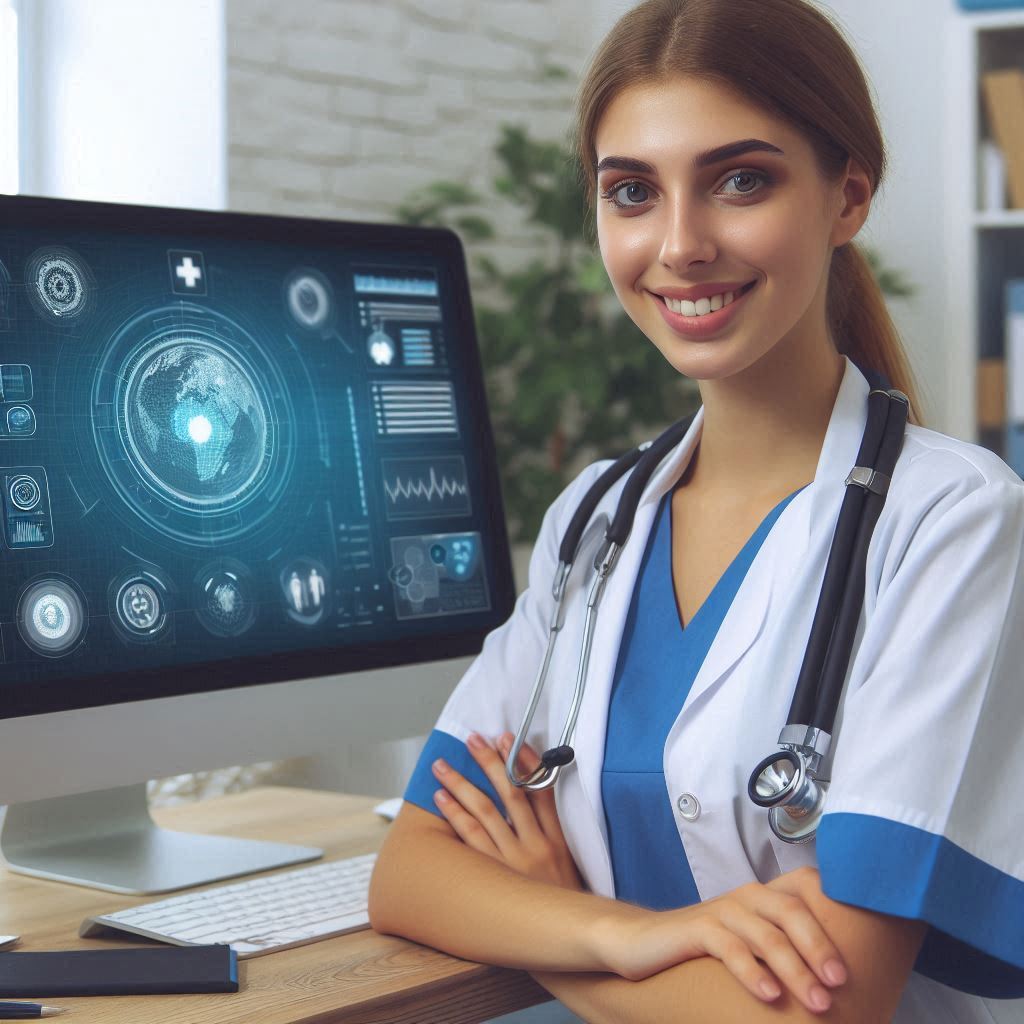Introduction
Health information technology (HIT) plays a crucial role in modern healthcare. It streamlines processes, enhances patient care, and ensures data accuracy.
Rapid advancements in technology are revolutionizing the healthcare industry.
These changes bring innovative solutions to old problems and introduce new possibilities.
HIT facilitates better communication among healthcare providers, leading to improved patient outcomes.
Electronic Health Records (EHRs) are at the core of HIT. They enable seamless data sharing and quick access to patient information.
Telemedicine is another growing trend, providing remote healthcare services to patients. This technology improves access to care, especially in rural areas.
Artificial Intelligence (AI) is making a significant impact by aiding in diagnostics and personalized treatment plans.
AI algorithms can analyze vast amounts of data quickly and accurately.
Blockchain technology ensures the security and integrity of health data. It provides a transparent and tamper-proof system for managing patient records.
Wearable devices and mobile health apps empower patients to take control of their health. These tools provide real-time health monitoring and data collection.
The Internet of Things (IoT) connects medical devices, enabling continuous patient monitoring.
This connectivity allows for proactive healthcare and timely interventions.
Interoperability is a critical focus, ensuring different HIT systems work together seamlessly. This integration enhances care coordination and reduces errors.
The future of HIT promises more patient-centric care and advanced data analytics.
As technology evolves, HIT will continue to transform healthcare, making it more efficient and effective.
Embracing these trends is essential for healthcare providers and patients alike.
Artificial Intelligence in Healthcare
Artificial Intelligence (AI) is revolutionizing the way healthcare providers diagnose and treat patients.
By leveraging AI technology, healthcare professionals can enhance the accuracy and efficiency of their practices.
Role of AI in Improving Diagnosis and Treatment
AI plays a crucial role in improving the diagnosis and treatment of various medical conditions.
It can analyze vast amounts of data quickly and with high accuracy, providing healthcare providers with valuable insights into a patient’s condition.
Transform Your Career Today
Unlock a personalized career strategy that drives real results. Get tailored advice and a roadmap designed just for you.
Start NowOne of the key benefits of AI in healthcare is its ability to process complex medical imaging, such as CT scans and MRIs, to detect signs of disease or injury that may be missed by human eyes.
AI algorithms can identify patterns and anomalies in these images, helping doctors make more accurate diagnoses.
Moreover, AI can analyze genetic and molecular data to predict a patient’s risk of developing certain diseases and personalize treatment plans based on their individual characteristics.
This personalized approach to healthcare can lead to better outcomes and a higher quality of life for patients.
Examples of AI Applications in Healthcare
There are several examples of AI applications in healthcare that are already making a significant impact on the industry.
Virtual health assistants are one such example, providing patients with round-the-clock access to healthcare information and advice.
Virtual health assistants can answer questions, schedule appointments, and even provide reminders for medication.
By leveraging AI technology, these virtual assistants can learn from their interactions with patients and continuously improve the quality of care they provide.
Another example of AI in healthcare is predictive analytics, which uses machine learning algorithms to analyze historical data and identify patterns that can help predict future health outcomes.
This can be particularly useful in disease prevention and early intervention.
For instance, predictive analytics can help healthcare providers identify patients at risk of developing chronic conditions, allowing them to intervene early and prevent the progression of the disease.
This proactive approach to healthcare can ultimately lead to cost savings and improved patient outcomes.
In fact, the integration of AI in healthcare is transforming the way providers diagnose and treat patients.
By harnessing the power of AI technology, healthcare professionals can improve the accuracy and efficiency of their practices, leading to better outcomes for patients.
Read: Health Information Technician Code of Ethics
Telemedicine and Remote Monitoring
Telemedicine is revolutionizing patient care by providing remote access to healthcare professionals.
Patients can consult with doctors via video conferencing from the comfort of their own homes.
This has been especially valuable during the COVID-19 pandemic when in-person appointments were limited.
Benefits of Telemedicine
- Improved Access to Care: Telemedicine eliminates the barriers of distance and travel, making healthcare more accessible to patients in remote areas or those with limited mobility.
- Time and Cost Savings: Patients save time and money by avoiding the need to travel to a physical clinic. This convenience also leads to fewer missed appointments.
- Enhanced Monitoring: Providers can remotely monitor patients’ vital signs, symptoms, and medication adherence, allowing for proactive intervention and personalized care plans.
- Increased Efficiency: Telemedicine streamlines the healthcare process by reducing paperwork, wait times, and administrative tasks, resulting in a more efficient patient experience.
- Continuity of Care: Telemedicine ensures continuity of care by enabling seamless communication between patients, caregivers, and healthcare providers, even when face-to-face visits are not possible.
Remote monitoring devices play a crucial role in managing chronic conditions by enabling continuous tracking of patients’ health status and vital signs.
These devices collect real-time data and transmit it to healthcare providers for analysis and intervention when necessary.
Transform Your Career Today
Unlock a personalized career strategy that drives real results. Get tailored advice and a roadmap designed just for you.
Start NowImpact of Remote Monitoring Devices
- Early Detection of Complications: Remote monitoring devices detect subtle changes in a patient’s condition, allowing for early intervention before a problem escalates.
- Improved Disease Management: Patients with chronic conditions benefit from remote monitoring as it helps them better manage their symptoms, adhere to treatment plans, and prevent exacerbations.
- Personalized Care: Healthcare providers can tailor treatment plans based on the data collected from remote monitoring devices, leading to more personalized and effective care for patients.
- Reduced Hospitalizations: By monitoring patients remotely, healthcare providers can prevent unnecessary hospitalizations, reduce healthcare costs, and improve patient outcomes.
- Empowerment and Engagement: Remote monitoring devices empower patients to take control of their health and engage in their own care management, resulting in better health outcomes and quality of life.
In short, telemedicine and remote monitoring are transforming patient care by increasing access, efficiency, and personalized treatment options.
The integration of technology in healthcare is revolutionizing the way we deliver and receive medical services, ultimately improving patient outcomes and satisfaction.
Read: Importance of Accuracy in Health Information Technology
Blockchain Technology in Healthcare
Enhancing Data Security and Interoperability
Blockchain technology is revolutionizing the healthcare industry by providing a secure and transparent way to store and share data.
With its decentralized and encrypted nature, blockchain ensures that sensitive medical information is protected from unauthorized access or tampering.
One of the key advantages of blockchain technology is its ability to enhance data security.
Traditional methods of storing healthcare data are vulnerable to cyber attacks and breaches.
By utilizing blockchain, healthcare organizations can ensure the integrity and confidentiality of patient information.
Moreover, blockchain promotes interoperability by allowing different healthcare providers to access and share data seamlessly.
This is particularly beneficial for patients who may receive treatment from various specialists or facilities.
With blockchain, authorized parties can securely access a patient’s medical history and treatment records in real-time.
Examples of Blockchain Use Cases in Healthcare
- Secure Medical Records: Blockchain technology can be used to create a tamper-proof ledger of patient information.
This ensures that medical records are accurate, up-to-date, and accessible only to authorized personnel. - Drug Supply Chain Tracking: Blockchain enables the tracking of pharmaceutical products from the manufacturing stage to the end-user.
This enhances transparency and reduces the risk of counterfeit drugs entering the market. - Clinical Trials and Research: Blockchain facilitates the secure sharing of clinical trial data among researchers, pharmaceutical companies, and regulatory bodies.
This improves collaboration and accelerates the development of new treatments and therapies. - Health Insurance Claims Processing: By leveraging blockchain, healthcare providers can streamline the claims processing and verification process.
This reduces administrative costs and minimizes fraudulent activities in the billing and payment systems. - Telemedicine and Remote Monitoring: Blockchain technology can support telemedicine services by securely storing patient consultations, prescriptions, and treatment plans on a decentralized network.
This ensures that patient data remains confidential and accessible to authorized healthcare professionals.
In general, blockchain technology offers numerous benefits for the healthcare industry, including enhanced data security, improved interoperability, and streamlined processes.
As the adoption of blockchain continues to grow, we can expect to see further advancements in healthcare delivery and patient care.
Read: What Does a Clinical Social Worker Do in Healthcare?

Wearable Technology and Health Apps
Increasing popularity of wearable devices for monitoring health metrics
As technology continues to advance, the use of wearable devices for monitoring health metrics has become increasingly popular.
These devices, such as fitness trackers, smartwatches, and other wearable sensors, provide individuals with real-time data on their physical activity levels, heart rate, sleep patterns, and more.
The ability to track these metrics allows users to gain valuable insights into their overall health and make more informed decisions about their wellness habits.
Health apps have also played a significant role in promoting wellness and disease management.
These mobile applications offer a wide range of functions, from tracking diet and exercise to providing personalized coaching and reminders for medications.
Health apps have made it easier for individuals to take control of their health and adhere to treatment plans, leading to improved health outcomes.
Transform Your Career Today
Unlock a personalized career strategy that drives real results. Get tailored advice and a roadmap designed just for you.
Start NowImpact of health apps in promoting wellness and disease management
Here are some key points to consider when exploring the impact of wearable technology and health apps on healthcare and individual wellness:
Increased Patient Engagement
Wearable devices and health apps encourage individuals to actively monitor their health and stay engaged in their wellness journey.
By providing users with personalized data and feedback, these technologies empower individuals to take charge of their health and make positive lifestyle changes.
Increased engagement can lead to better adherence to treatment plans and improved health outcomes in the long run.
Remote Monitoring and Telemedicine
Wearable technology enables healthcare providers to remotely monitor patients’ health metrics in real time, allowing for more proactive and personalized care.
Health apps can also facilitate telemedicine services, connecting patients with healthcare professionals through virtual consultations and remote monitoring.
This remote approach to healthcare delivery has become especially important during the COVID-19 pandemic, as it minimizes the need for in-person visits and reduces the risk of exposure to the virus.
Integration with Electronic Health Records (EHRs)
The data collected from wearable devices and health apps can be seamlessly integrated with electronic health records, providing healthcare providers with a more comprehensive view of a patient’s health history and current status.
This integration allows for better-informed clinical decision-making and more personalized treatment plans tailored to individual needs.
By leveraging this data, healthcare providers can deliver more efficient and effective care, ultimately improving patient outcomes.
Health Behavior Change
Wearable technology and health apps have the potential to influence health behavior change by promoting healthy habits and encouraging individuals to adopt a more active lifestyle.
By setting goals, tracking progress, and receiving feedback, users can make incremental changes to their behavior and establish long-lasting habits that support their overall well-being.
These tools can also provide motivational incentives, social support, and educational resources to help individuals achieve their health goals and sustain positive behavior change over time.
Data Privacy and Security
With the increasing use of wearable technology and health apps, concerns about data privacy and security have become more prominent.
It is essential for users to understand how their personal health data is collected, stored, and used by these technologies, as well as the measures in place to protect their information from unauthorized access.
Health app developers and device manufacturers must adhere to strict privacy regulations and cybersecurity standards to safeguard user data and maintain trust in the healthcare system.
In review, wearable technology and health apps have become valuable tools for promoting wellness, improving disease management, and empowering individuals to take control of their health.
By leveraging these technologies, healthcare providers can deliver more personalized and proactive care, while individuals can gain valuable insights into their health metrics and make informed decisions about their well-being.
As the field of health information technology continues to evolve, the integration of wearable devices and health apps into clinical practice will play an increasingly important role in shaping the future of healthcare delivery and individual wellness.
Read: Path to Becoming a Clinical Social Worker in the USA
Transform Your Career Today
Unlock a personalized career strategy that drives real results. Get tailored advice and a roadmap designed just for you.
Start NowGenomics and Precision Medicine
How genomics is revolutionizing healthcare by tailoring treatment to individual genetic profiles
Genomics, the study of an individual’s genetic composition, is revolutionizing healthcare in several ways:
- It allows for tailoring treatment to an individual’s genetic profile.
- This personalized approach leads to more effective and targeted interventions.
- Genomics helps identify genetic predispositions to diseases, enabling preventive measures.
Potential of precision medicine to improve outcomes and reduce healthcare costs
Precision medicine, a concept closely linked to genomics, holds immense potential for improving healthcare outcomes:
- By using genetic information, healthcare providers can customize treatment plans.
- This customization can lead to better patient outcomes and reduced healthcare costs.
- Targeted therapies based on genetic profiles are more effective and have fewer side effects.
Overall, the integration of genomics and precision medicine in healthcare is leading to a paradigm shift towards personalized and more effective treatments based on individual genetic makeup.
Data Analytics for Population Health
One of the key areas of growth in health information technology is data analytics for population health.
Importance of Data Analytics in Identifying Public Health Trends
- Data analytics plays a crucial role in identifying public health trends by analyzing large datasets.
- It enables healthcare providers to track patterns, detect outbreaks, and predict future health trends.
- By analyzing data, public health officials can make informed decisions to improve population health outcomes.
Examples of Population Health Initiatives Using Data Analytics
- Predictive Modeling: Healthcare organizations use data analytics to develop predictive models for identifying patients at risk of certain diseases.
- Disease Surveillance: Data analytics tools help in monitoring and tracking the spread of infectious diseases in real-time.
- Outcome Improvement: By analyzing outcomes data, healthcare providers can identify areas for improvement and implement targeted interventions.
In a nutshell, data analytics is a powerful tool in population health management, enabling healthcare organizations to make data-driven decisions to improve public health outcomes.
Cybersecurity Challenges in Health IT
Importance of Cybersecurity in Health IT
Cybersecurity is a critical aspect of Health IT due to the sensitive nature of patient information.
As healthcare organizations transition to digital systems, the risk of cyber threats increases.
Rising Concerns Around Cybersecurity Threats
With the increasing digitization of healthcare data, cyber threats have become more sophisticated and prevalent.
Hackers target healthcare organizations to access valuable patient information and exploit vulnerabilities in IT systems.
Consequences of Data Breaches in Healthcare
Data breaches in healthcare can have severe consequences, including compromising patient confidentiality, financial loss, damage to reputation, and legal ramifications.
It is essential for healthcare providers to prioritize cybersecurity to safeguard patient data.
Strategies for Enhancing Cybersecurity in Health IT
- Implement Strong Authentication Measures: Utilize multi-factor authentication to verify user identity and prevent unauthorized access to sensitive data.
- Regular Security Audits: Conduct periodic security audits to identify vulnerabilities in IT systems and address them proactively.
- Employee Training: Provide comprehensive cybersecurity training to staff members to raise awareness about best practices for data protection.
- Encryption of Data: Encrypt patient data to prevent unauthorized access and ensure data confidentiality in transit and at rest.
- Compliance with Regulations: Adhere to regulatory requirements such as HIPAA to ensure the secure handling of patient information and avoid penalties.
- Incident Response Plan: Develop a comprehensive incident response plan to mitigate the impact of cyber incidents and minimize disruption to healthcare operations.
- Collaboration with IT Security Experts: Partner with cybersecurity professionals to leverage their expertise in implementing robust security measures.
Future Trends in Cybersecurity for Health IT
As technology continues to advance, health IT cybersecurity will evolve to combat emerging threats.
AI and machine learning will play a significant role in enhancing cybersecurity measures by predicting and preventing cyber attacks in real-time.
Basically, cybersecurity is a crucial aspect of Health IT that requires continuous vigilance and proactive measures to safeguard patient data in an increasingly digital landscape.
Discover More: How to Transition from Medical Billing to Coding
Conclusion
As we look towards the future of health information technology, several key trends stand out.
The integration of artificial intelligence and machine learning will revolutionize healthcare by improving diagnostics and treatment plans.
Telemedicine and remote monitoring will continue to gain popularity, allowing for more efficient and accessible care delivery.
Electronic health records will become more comprehensive and interoperable, streamlining communication between healthcare providers.
Wearable devices and health apps will empower individuals to take charge of their health and wellness.
Transform Your Career Today
Unlock a personalized career strategy that drives real results. Get tailored advice and a roadmap designed just for you.
Start NowCybersecurity will remain a top priority to protect patient data and ensure the confidentiality of medical records.
It is essential for healthcare organizations to leverage technology to enhance patient care and improve healthcare outcomes.
By embracing these future trends, we can create a more efficient, effective, and patient-centered healthcare system.




